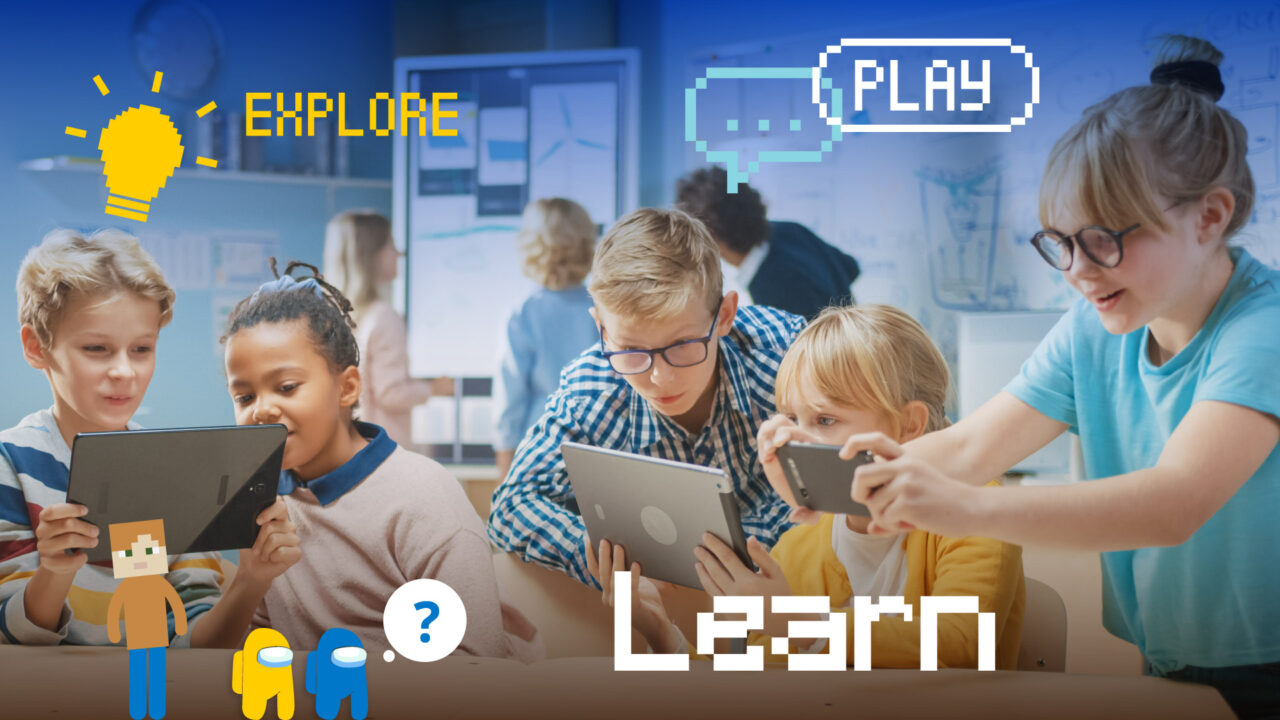Exploring Participation with Videogames
Year of production: 2023

Download the full report "Exploring Participation with Videogames"
APPLICATION - 3.76 MB
Youth work aims to use what is popular and widespread among young people, as a way to engage young people themselves in experiences, from which learning can be identified and assessed: be it sports, music, games or other, it is the very core of non-formal education to offer experiences that can be engaging, starting from what our target groups already know, practice and like.
Why this publication?
There is no doubt that videogames have grown to be very popular and well-spread among young people over many years – so in this publication, SALTO Participation & Information Resource Centre (SALTO PI) decided to share examples and guidance on how videogames have been used in the context of non-formal education to explore youth participation in civic society. With this activity, we put extra emphasis on the methodology of how anyone can introduce this learning tool into their work.
SALTO PI believes and knows that no decision about young people should be made without their involvement. Youth participation is and should be an integral part of democratic governance on all levels. SALTO PI encourages outreach work to involve a wider and more diverse range of young people in youth participation in democratic life. SALTO PI promotes meaningful youth participation in all levels of society, which includes education, policy making, work places, the community, etc. and for all young people including those with disabilities, from refugee and migrant backgrounds, LGBTIQ communities, NEET, etc. Furthermore, we create space and capacity for meaningful, inclusive and innovative participation practices in democratic society. For the past 2 years, we have put more focus on digital tools, resources and spaces where participation can occur. This publication explores the space of videogames as one where democracy can take place to approach the discussion in a gamified way. To see more methods on how to make your project more participatory, please have a look at the Youth Participation Toolkit. If you’d like to learn more about tools that can be used for participation, please take a look at the Participation Resource Pool.
Negative effects of videogames on young people have been studied thoroughly, but research about positive outcomes has only started to appear recently. According to Adachi and Willoughby 2017:
Although many studies have examined the impact on youth of playing videogames on negative outcomes, such as aggression and addiction, few studies have investigated potential positive outcomes. This imbalance is being addressed. […]
Overall, research on the benefits of playing videogames suggests that games may be a tool for interventions that promote problem solving, intergroup relations, physical activity, and well-being. Of course, attention to potential negative outcomes of playing videogames is also important, but a balanced approach to studying videogame play will enhance our ability to understand and promote positive youth development.
Thus we decided to investigate practices of using videogames for positive youth development in a rather unexplored field, the one of participation, active citizenship and democracy, encompassing it within a larger framework including processes of decision-making, collaborative design of public spaces, informed choices and other elements, which are indeed the basic building blocks in building a democratic and participative society.
What do we mean by youth participation?
When we talk about participation, we should remember that we are talking about something which, according to the definitions of Participation in the Youth Participation Strategy, has the following characteristics:
Youth participation in democratic life is about individual young people and groups of young people having the right, the means, the space, the opportunity and, where necessary, the support to freely express their views, contribute to and influence societal decision-making on matters affecting them, and be active within the democratic and civic life of our communities.
We believe that videogames as a virtual space could be an ideal setting to train and foster young people’s participation skills, because they can offer all these experiences in a long-lasting process.
In this process, players are requested to take a stance on many different and diverse situations, and where the aspect of decision-making is immediately able to change the context and make the impact as visible as possible.
Even when simply used as a tool to promote participation not only between players, but to the more general political process, videogames have proven their value: In October 2020 the very popular US Congress member Alexandria Ocasio-Cortez played Among Us live on her Twitch channel, collecting an incredible audience of 439,000 viewers (when Trump and Biden streamed their online events, they peaked at 6,000 and 17,000 viewers respectively). This marked a major success in outreach and participation, reportedly because “everybody was just acting normal”. The Congress member didn’t miss an opportunity to capitalise on her political messages, for example declaring “I am voting early” during one in-game emergency meeting, and thus promoting early registration and voting in the upcoming US elections.
Videogames often reproduce some very interesting decision-making processes, and in that sense, they offer powerful learning experiences. Solo gaming can be seen as quite a solitary experience, detrimental to a young person’s social and communication skills, but as cooperative online environments keep growing in number and popularity, the picture becomes quite different. It has actually been observed that cooperative gaming produces “higher friendship quality and more prosocial behavior”, and even more so when players are already friends.
This is especially the case with adolescents, where videogames are seen primarily as an excuse to hang out with friends, and people who do not know each other would rarely play an offline game together. In this context we collected experiments of educational activities with and inside videogames as a first attempt in using these media with an educational aim.
Participation in decisions, or having an impact
It is especially interesting to observe how decisions are taken in a group situation, and some videogames are made just for this. They can lead to powerful learning moments and have many applications in training and educational settings. It is well known that decision-making abilities and cognitive functions are particularly developed among video game players, but the question for educators and youth work practitioners is often “how can we channel this impressive amount of learning out of the videogame sphere, and put it to good use?”.
This publication aims to be a first guide in this direction, exploring practices in a very detailed and concrete way, and offering an analysis of a few recent pioneering experiences coming from the youth field, so that you can get inspiration from them, and create your own videogame-based learning experiences to foster participation, decision-making, etc. in your target groups.
What videogames are we talking about?
We purposely decided to strictly focus on mainstream videogames; the ones being played by young people (and not only) in millions, and being successful products in the gaming industry: these are the games that young people would play anyway, the games they already play at home, alone or with friends, either in person on connected online. There are of course thousands of “indie” videogames as well, sometimes even more directly connected to educational topics, and there is even a category of “serious” games, that we deliberately decided to ignore for now: a game should be played for fun first of all, and labelling it as “serious” does not really hint in that direction. Imagine for a second proposing to a group of young people to “play a serious game” or a world-famous videogame instead: what would their choice be? We believe that using mainstream videogames could be the best strategy to apply educational purposes to the games themselves, as they will be played for fun in the first place, and the learning coming from them would then be identified with the help of youth workers’ skills and intervention after the experience.
Observing some of these games, one gets to understand that sometimes they are borrowing the same structures and dynamics of games which are often being used in contexts like youth exchanges (as for “Among Us”). Other games are indeed sandbox systems, just like Lego bricks have been for so many years, and in the same way they can be used to engage with a group in many different ways (as for “Minecraft”).
Identifying what could be used in those mainstream videogames to connect them to a non-formal education activity is something that these experiences can help us to define, and it is generally the result of a trial & error process. Asking young people which are their favourite games, and opening a conversation with them about what happens in those games, what the engaging elements are, and what they can learn while playing, are possible strategies to help us choose the games we want to try out.
Videogames and learning
Educational use of mainstream videogames has been studied for years already, and some milestone findings are for instance to be found in the works of Prof. James Paul Gee, who dedicated much effort to showing how the formal education system could really benefit from a closer relationship with games and videogames. Surprisingly enough, the non-formal education sector, which always had a clear and long-lasting connection with games as a way to learn, have generally not embraced the possibility to use videogames in the same way so far. We have had books explaining how to set up a gaming zone in a public library since 2007, but the first publication about videogames in non-formal education (which is also the only one so far that we were able to find) was only published in 2015.
Another milestone in videogame studies is the famous book by game designer Jane McGonigal, Reality Is Broken, where she showed for the first time in 2011 to the general public a possible link between playing videogames and addressing real-life issues and problems: McGonigal focused on the various skills that videogames could help us to foster, thus indirectly helping to improve humankind’s capacity to solve real challenges.
After reading this book we can’t help noticing, for instance, that a generation growing up playing videogames aimed at managing scarce resources in order to develop and improve your in-game communities (from “Age of Empires”, to “Minecraft” itself) is the one finally identifying climate change and environmental issues as crucial problems to solve, and we would love to find more data and research about this possible connection.
For those of you interested in the carbon footprint of videogames, some research has recently finally started to appear. We should always remember that digital tools and media have an environmental impact as well, and this aspect is often not considered; then again, videogames can also be an effective way of tackling the topic of environmental impact and carbon footprint with young people.
Decision-making in videogames
Now let’s use the lens of participation and try to observe all the situations in which decision-making is implied, in which elements and components of a democratic process are simulated or enacted by young people while playing, and so on. When observing videogames with participation in mind, the real turning point has surely been the growing popularity of multiplayer online games, where a group of people can play together while being connected online. This brought the topic of participation directly inside the game, putting players towards challenges such as having to quickly agree on a common strategy, and then seeing the result of their choices changing the following steps of the game. The added value of having this shared experience in a videogame is for instance that if you make the wrong decision, you can always play again and go in a different direction, or apply the knowledge you got from previous mistakes to the next choices. Learning from mistakes should be a common way to improve our practice; non-formal educational approaches already have the lead in this perspective, and videogames could take it even further.
Inside this publication
In this publication you will find three contributions using different videogames, such as “Minecraft”, “Civilization”, “Among Us” to offer examples of activities aimed at fostering skills in decision-making, civic planning, participatory design and more. These articles will be focused on giving practical information about what to do, what to keep in mind and what to be aware of, when designing and delivering educational activities of this kind.
We kept a similar structure for the three articles, showing why that specific game was chosen, what should be remembered from a technical point of view when using it, and underlining what the role of youth workers in the process, in the preparation, while playing and after the game would be.
We hope that this publication can help you to experiment with the use of videogames to tackle participation in your youth work settings and with your target groups, and we would be very happy to learn more about how you used the ideas and concepts shared in these articles.
Conclusions
We collected and reviewed a few experiences, regarding experiments on youth participation based on videogames such as Minecraft (with one and another example), Among Us and Civilisation 6.
These examples are only the first recognition of what is happening with videogames and learning, and can be spread in the youth work circuit. More examples are out there, also in formal education environments, about the use of videogames to provide spaces for learning in a new and engaging way. The faculty of History of Charles University in Prague even created their own software house, to produce videogames aimed at teaching contemporary history with content validated and verified by University professors.
The formal education sector including videogames in the student-based learning experience is an interesting factor that we should consider, when trying to figure out where future developments and the digital transformation of non-formal education could be headed.
Using videogames in non-formal education
From the experiences we collected, we believe that at least a few points of interest can be identified through generally using videogames in non-formal education settings.
Videogames and devices to play them, now have costs which may be affordable in many youth work contexts; youth clubs and youth centres could provide gaming PCs or consoles to their target groups in the same way as they offer other kinds of games or materials in their venues; it is not science fiction we are talking about, but something which is already part of the everyday habits of a lot of young people, and could be used as a (new) space for learning.
Using videogames as a space for learning could provide gaming experiences that are happening under the eyes of youth workers, who could then be sure of the safety of these experiences (respecting PEGI advices while choosing games, avoiding toxic behaviour in group gaming, etc.) and taking advantage of the experience, opening up discussions and activities to analyse what happened while gaming, and identifying participants’ learning.
Videogames and participation
Focusing more specifically on participation, from these experiences we can say that a group-gaming activity, either sharing the controls of a single device or even better, playing together from different devices as in the examples we provided, could provide many possibilities to explore and discuss participation or important steps of participation processes, such as collective decision-making, taking informed decisions, analysing the impact of decisions, etc.
Still focusing on participation and videogames, the role of youth workers in this process is crucial: the most important aspect of every experience we collected here is when a debriefing discussion about the experience starts, guided by a youth worker.
In the Introduction to this collection we also underlined that, so far, the experiences listed here are the results of trial and error by a few youth workers, and one aim of these articles is also to show how it could all possibly be replicated by more youth workers willing to try out developing other possible practices themselves.
The important point thus is not being a gamer or a videogame expert, but being able to recognise which aspects of the game that your youth target group are using, could also be employed to tackle participation or aspects connected with participation.
Important in-game elements
We identified the decision-making moments within a group game as the easiest space to analyse dynamics and learn from them, and we see that two game elements so far seem to be ensuring a richer participation experience:
- the in-game possibility to manage resources in an interconnected way, meaning that the effects of the choices of one player will affect all the rest; this happens in our examples based on Civilisation and Minecraft;
- the in-game possibility of deciding together where to further take the game action; this happens in Civilisation and Among Us, and can easily be incorporated in a youth-worker supervised Minecraft game. In fact, this could be incorporated in every multiplayer videogame.
To discuss participation in a youth group using videogames, a youth worker could stress these features of the game experience and debrief with the players, then introducing the idea of informed decision-making to underline the need for knowledge (of materials needed and crafting recipes in Minecraft, of the impact on the climate of your industrial development in Civilisation, etc.), which could open a wide possibility of connecting participation and information, too.
The so-called sandbox games, where there isn’t a clearly identified aim (as when playing Minecraft in Creative Mode), are probably the best choice for deciding together how to develop the games’ actions, as described in the second article about Minecraft.
We should always remember that in any case, everything in a game only exists after a choice has been made by the developers to include it, so even sandbox or open-world games are subject to rules, boundaries and limitations, even if they may sometimes be harder to identify.
This brings us to the last and very relevant aspect of everything happening in digital form: this form has been shaped, designed, defined by someone in advance, it is possibly owned by this someone, and quite often the internal rules of such a space are defined by the same someone.
Every time we bring up participation in digital spaces, including videogames, we should make sure that all participants are fully aware of this condition, and maybe plan some warm-up exercises to help them understand and remember these boundaries.








